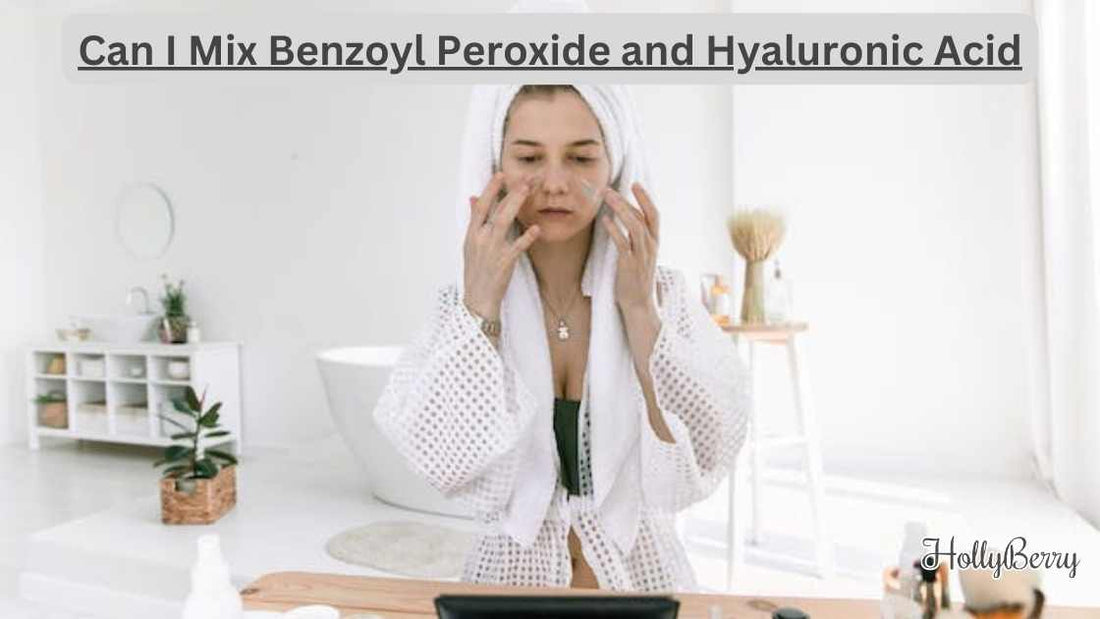
Can I Mix Benzoyl Peroxide and Hyaluronic Acid
Share
Unveiling Skincare Combinations

Navigating the intricate landscape of skincare can be daunting, especially when it involves combining active ingredients.
Two substances frequently brought into the spotlight are benzoyl peroxide and hyaluronic acid. Benzoyl peroxide is an established acne treatment, lauded for its antibacterial properties and its ability to reduce inflammation and clear clogged pores.
On the other hand, hyaluronic acid has gained a reputation for being a powerful humectant, capable of retaining moisture in the skin and thus, playing a role in combating wrinkles and promoting a plump, hydrated complexion.
When considering a skincare routine that incorporates both benzoyl peroxide and hyaluronic acid, timing and product formulations are critical.
While benzoyl peroxide can be quite drying and cause irritation due to its potency against acne, hyaluronic acid serves as a soothing counterpart that helps to maintain hydration levels in the skin.
It is commonly advised to use benzoyl peroxide initially, often as a cleanser to target acne-causing bacteria, and follow up with a hyaluronic acid product to alleviate any potential dryness. This sequence helps in managing acne without compromising on skin's hydration.
While the combination, when used appropriately, offers a synergistic approach to hydrate and treat acne-prone skin, each individual's skin response can vary.
Care should be taken to slowly introduce these ingredients into one's skincare regime, observing how the skin reacts and adjusting as necessary to avoid over-irritation or dehydration.
It is recommended to consult with a dermatologist to tailor a routine that best suits individual skin concerns and conditions.
Understanding Benzoyl Peroxide and Hyaluronic Acid
In skincare, combining ingredients effectively is key for optimal results. This section focuses on the interaction between benzoyl peroxide, an acne-fighting agent, and hyaluronic acid, a hydration booster, considering their functions, possible conflicts, synergies, and safety across different skin types.
Benefits and Functions
Benzoyl Peroxide is known for its antibacterial properties and ability to combat acne by penetrating the skin and targeting bacteria.
It is also helpful in clearing clogged pores and reducing inflammation, making it a potent ingredient for those combating pimples and blemishes.
On the other hand, Hyaluronic Acid is renowned for its moisture-retaining qualities, which aid in keeping the skin hydrated, thereby minimising the appearance of fine lines. As an ingredient in serums and moisturisers, it can enhance skin plumpness and hydration levels.
Potential Conflicts and Synergies
Though beneficial on their own, these ingredients may have potential conflicts when used simultaneously.
Benzoyl peroxide can cause dryness and irritation, counteracting the hydrating benefits of hyaluronic acid.
However, when used synergistically, they can address skin concerns effectively: hyaluronic acid can help mitigate dryness caused by benzoyl peroxide, while benzoyl peroxide treats the acne that hyaluronic acid cannot affect.
Safety and Skin Types
Each ingredient suits different skin types and conditions. Benzoyl Peroxide is often recommended for oily and acne-prone skin but can be harsh for those with sensitive skin, leading to side effects like redness and peeling.
In contrast, Hyaluronic Acid is generally safe for all skin types, including sensitive skin, due to its non-irritating nature. It acts as an antioxidant, protecting the skin from environmental stressors while assisting in maintaining skin hydration.
Safely integrating both ingredients into a skincare routine requires understanding one's skin type and monitoring for any signs of irritation, especially when first incorporating benzoyl peroxide.
Incorporating Into Skincare Routine
When incorporating benzoyl peroxide and hyaluronic acid into a skincare routine, one should apply products in a sequence that maximises effectiveness while maintaining skin hydration and barrier integrity.
It's essential to work these ingredients into a regimen that includes moisturiser, sunscreen, and possibly other actives like niacinamide or retinol for a comprehensive approach to skincare.
Step-by-Step Application
- Cleanse: Begin with a gentle cleanser to remove impurities without stripping the skin of its natural oils.
- Benzoyl Peroxide: Apply a benzoyl peroxide treatment, focusing on acne-prone areas for targeted spot treatment. Use a lower concentration to minimise irritation.
- Hyaluronic Acid: After the benzoyl peroxide has been absorbed, follow with a hyaluronic acid serum to provide deep hydration.
- Moisturise: Seal in the hydration with a moisturiser suitable for your skin type to help maintain a healthy skin barrier.
- Sunscreen: During the day, finish with a broad-spectrum sunscreen to protect the skin from UV damage. This is crucial as benzoyl peroxide can increase photosensitivity.
Additional Compatible Skincare Ingredients
- Niacinamide: May be included to help reduce inflammation and support the skin barrier.
- Retinol: Can be used in an evening routine but separated from the time of benzoyl peroxide application to avoid potential irritation.
- Ceramides and Glycerin: Look for these in moisturisers to provide additional barrier support and hydration.
- SPF: Always use sunscreen during the day as part of the routine, especially when using active ingredients that may sensitize the skin to sunlight.
